Bandon Hill
Bandon Hill, Sutton
Also spelt as a single word, Bandon Hill is a railside residential locality without a station, situated on the east side of Wallington

The discovery of Roman funeral urns (in the 1970s) indicates the presence of a burial ground on the site of the present Bandon Hill cemetery as early as the 1st century AD.
The manor of Bandon was first recorded in 1203. There is a slight possibility that early resident Roger de Bandon brought the name with him from elsewhere but it is much more likely that he took his surname from this place. Variously spelt Bandon, Bandone and Bendon in the early 13th century, the name would have meant ‘bean down’ – the hill where beans are grown. In the Middle Ages broad beans were an essential foodstuff for the poor. Benhilton, another locality in the borough of Sutton, also gets its name from the cultivation of beans on a hill.
As is often the case with the ‘down’ and ‘hill’ affixes in London place names there is not much of a hill hereabouts, merely undulating terrain on the lower dip slope of the North Downs, mostly 50–60 metres (or around 160–200 feet) above sea level.
In the Middle Ages, Bandon was a more important settlement than nearby Beddington but all trace of it has vanished and even its exact location is now forgotten. Loosely gathered around a manor house, the village probably lay between Beddington and Waddon.

The tautological name Bandon Hill was a later invention, which was applied to the rising ground south of Beddington, to the settlement that began to take shape here after the Croydon to Epsom railway line came through in 1847, and to the cemetery that was opened by Croydon rural district council in 1900.
Bandon Hill was an unplanned development, built a few houses at a time by small-scale speculators. The first streets to be filled with homes were Upper Road, the west side of Plough Lane and Beddington Grove Road (now Sandy Lane North), which had an inn. Bandon railway halt brought some commuters during its brief existence from 1906 to 1914.
Bandon Hill primary school’s ‘Meadow Field’ site occupies the original location of St Michael and All Angels church, which had been established in 1872 and moved west onto Milton Road in 1907. Bandon Hill Methodist church opened in 1912.
The settlement expanded progressively throughout the 20th century, first westward and then in all other directions until it met the neighbouring built-up areas. All available gaps were plugged – except for the cemetery, the Demesne Road allotments, a couple of sports grounds and Mellows Park, which has a bowling green and café, among other amenities.
Since 1995, with the exception of graves for cremated remains, new burial rights at Bandon Hill cemetery have only been available for reclaimed graves – which are old graves that have burial space remaining but have not been used for at least 75 years. On 24 March 2006 the cemetery conducted its 30,000th interment.
In addition to its original home on Sandy Lane, Bandon Hill primary school has expanded onto a site on Stanley Park Road (which, by any definition, is not in Bandon Hill). The school attracted the attention of the national media in 2014 when the head teacher’s salary rose above £200,000. Her remuneration package was subsequently reduced.
Except in the context of the cemetery and the primary school, Bandon Hill’s name is not widely recognised – though it does appear in several street atlases, usually spelt ‘Bandonhill’. Most residents simply consider this locality to be part of Beddington or (more often nowadays) Wallington.
The African–British composer Samuel Coleridge-Taylor, best-known for Hiawatha’s Wedding Feast, was buried at Bandon Hill cemetery in 1912, following his death in Croydon at the age of 37.
